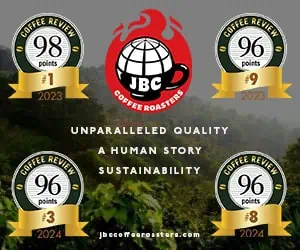The West Coast is doubtless the cradle of American espresso culture. True, Caffe Dante and Caffe Reggio were serving cappuccino in Manhattan long before the pioneering San Francisco and Berkeley caffes opened, and little storefront social clubs served espresso to domino and card players in Italian neighborhoods across the country for decades. But the whole business broke out of Italian enclaves and became decisively Americanized somewhere between the moment the first caffe latte was served, perhaps at the Caffe Mediterraneum in Berkeley in about 1958, and the late 1980s when Seattle emerged for its few years of fame as ground zero for an explosion of music and coffee innovation.
American espresso cuisine has taken its own milky, sweet, sometimes absurdly baroque multi-flavored direction. As any visitor to Italy knows, the gigantic caffe latte is an American invention, a mutant Godzilla of a drink born out of Americans’ need for sheer volume and quantity. Other developments both strange and useful followed, from the bizarre “dry” cappuccino with its coffee-resistant pile of meringue-like froth, to towering holiday lattes that submerge coffee in several ounces of eggnog and three flavors of syrup, to sensible innovations like soy milk drinks for the dairy-sensitive.
What is less obvious is the way American espresso coffees themselves differ from their Italian counterparts. While Italian-Americans in San Francisco of the 60s and 70s were roasting acidy, intense high-grown arabicas to dark, shiny, almost black roast styles, northern Italians were refining blends composed of low-grown, low-acid Brazils and neutral robustas brought to roast colors that were often lighter than West-Coast drip coffee. The San Francisco espresso blends I was raised on were deeply pungent at best, sharp and bitter at worst. The blends I tasted while visiting Italy were generally suave, subtle and silky, occasionally (when robustas got the upper hand) tasteless and bland.
On the American West Coast today such simple distinctions have been complicated by a sort of globalizing trend as newcomers, both Italians and Americans, modify or mix traditions to please their palates or their customers. Given the old Italian-American dark-roast traditions and the newer Italian-from-Italy influences, what is the current state of West-Coast espressos?
Coffee Review sampled ten West-Coast espressos from roasters ranging from aggressively expanding concerns like Seattle’s Torrefazione Italia to boutique roasters like the Los Angeles area’s City Bean Coffee and Napa Valley’s Calistoga Roastery. We tasted one single-origin Brazil and nine blends, including one decaffeinated blend.
Because there is no standard procedure for tasting espresso we continue to experiment with parameters for the tasting. For details see “Espresso Tasting: Controversy and Consensus” later in this article. Note that the samples were tasted blind, they were tasted in three ways – as a straight shot, diluted in water, and diluted in milk – and that I asked an experienced espresso professional to taste with me to confirm that the procedure generated results that reflected something resembling consensus American flavor expectations rather the my own rogue projections.
I had feared encountering some terminally overroasted espressos in this tasting, the thin and industrial-tasting kind I’ve often suffered through on the West Coast, but none turned up. Properly prepared, all of these coffees made quite respectable espresso, at least by American standards.
What did turn up were several blends at the dark end of the espresso-roast spectrum that displayed power and substance, but relatively little sweetness or top-end nuance. In other words, some of the sugars seemed to have been burned rather than caramelized, producing a pungent, smoky profile without the softening impact of sweetness. Even within this general profile there were interesting variations, however. Some blends preserved more sweetness than others; some nuanced the smoky tones with spicy or fruity notes. And the darkest espressos interacted with milk in interesting and unexpected ways.
To both me and my tasting partner the best of these espressos weighted in at the lighter end of the roast spectrum and displayed sufficient range of nuance and sweetness to complicate and balance their pungent tones. The surprising differences in the way many of the samples worked in mile may be owing to variations in body or viscosity that we had difficulty registering with consistency, and which eventually may require measurement by instrument if we are to genuinely understand espresso in the context of milk drinks.
Devoted readers of Coffee Review may note that a blend from Torrebazione Italia, the Perugia, is reviewed here a second time after also having been included in our October 1997 tasting. This repeat tasting was another effort at testing the consistency of the Coffee Review procedure.
The result was reassuring in part. Perugia Blend rated high in both tastings. The difference was that this relatively light-roasted blend intended for straight shots and short milk drinks, was rated at the top of this issue’s tasting with an overall score of 90, whereas in October it generated a second-highest rating of 86. Although I could blame the slight difference on variations in roast or blend formulation, I suspect instead it is owing to a change in our procedure. In October we tasted the samples diluted with water and with milk; this time around we added a straight shot to the tasting routine. Thus we were sampling the Perugia straight, as it was intended to be drunk, as well as diluted.
Espresso Tasting: Controversy and Consensus
In the opening issue of Coffee Review, I pointed out that coffee, unlike wine or beer, is a decidedly collaborative beverage. One party does the growing and harvesting, someone else removes the fruit and dries the coffee, someone else again, often thousands of miles away, roasts the coffee, and finally someone brews it.
In espresso, brewing is arguably the most decisive of the many steps from seed to cup. The window for success in espresso brewing is extraordinarily narrow. Minute variations in grind, a few seconds more or less while the coffee dribbles out, a half-ounce more or less water, can make the difference between a magnificent shot and a demitasse of bitterish black slime. A symposium on espresso I attended recently came close to erupting in fist fights over whether espresso is best brewed at temperatures of 195 F or a mere few degrees higher at 203 F. Both the sensitivity of espresso coffee to how it is brewed plus the lack of any clear consensus on tasting procedure means we at Coffee Review had to design our espresso tastings with great care.
First and most importantly, we rigorously controlled all brewing variables, since our purpose is not to judge brewing technique, but to evaluate the coffees themselves. When setting brewing parameters we followed the Specialty Coffee Association of America’s definition of espresso:
Espresso is a ¾-ounce to 1 ½-ounce beverage that is prepared from 7 to 9 grams of coffee through which clean water of 189F to 203F has been forced at 8 to 10 atmospheres of pressure, where the grind of the coffee has made brewing flow time approximately 22 to 30 seconds (from the time the pump has been turned on.) While brewing, the flow of espresso will appear to have the viscosity of warm honey and the resulting beverage will exhibit a thick, red-brown cream foam (“crema”) topping.
In our latest tasting, we maintained a flow time from the moment of the first drop of espresso appeared 22 to 25 seconds and a final volume per shot of 1 ¼ ounces. We used a La Marzocca semi-automatic two-group machine. We used a double dose of coffee (14 to 15 grams approximately) in the double portafilter with a medium tamp (30 to 40 pounds of pressure). We flushed the grinder between each sample and periodically vacuumed it.
In our first espresso tasting (October 1997) we sampled the aroma and observed the crema of straight shots, but only tasted the coffees in diluted form, one shot dilute with water and one with milk. I determined to omit tasting straight shots because I feared a sort of fuzzy tongue syndrome, a desensitizing of nose and palate by too much crema-rich sensation. After further talk and experiment, however, I decided that to fully assess body and aroma we did need to taste espresso samples as straight shots as well as diluted, and the cleansing the palate regularly with unsalted soda crackers and water as sufficient to keep the tasting faculties fresh. We also slightly reduced the amount of milk and water added to the diluted shots.
I’m convinced that the cumulative impact of these changes gives a more complete assessment of the samples than our previous diluted-only approach, although our latest procedure may have resulted in valuing espressos with subtler, more complex profiles over those with more power but perhaps less complexity.
In both tastings I asked an experienced espresso professional to participate with me using the same forms and procedures and sampling the same coffees, but without sharing scores or reactions until after our mutual tasting was concluded.
In both cases the two sets of scores were reassuringly parallel. In this latest tasting, for example, my tasting partner and I assigned overall scores 0 to 2 points apart for half of the samples, and 4 to 6 points apart for the others. The only one of the regular samples we differed on rather wildly (a 10-point difference) was the first one in the tasting, when I believe we were both distracted by our efforts to get started (the sample was excluded from the results.)
I hope to further test our tasting form and procedure by involving larger groups of professionals. For now, however, I think that we have come as close as possible, given the constraints imposed by the complex nature of espresso brewing and consuming, to a workable, consistent procedure for evaluating espresso in a North-American context.










